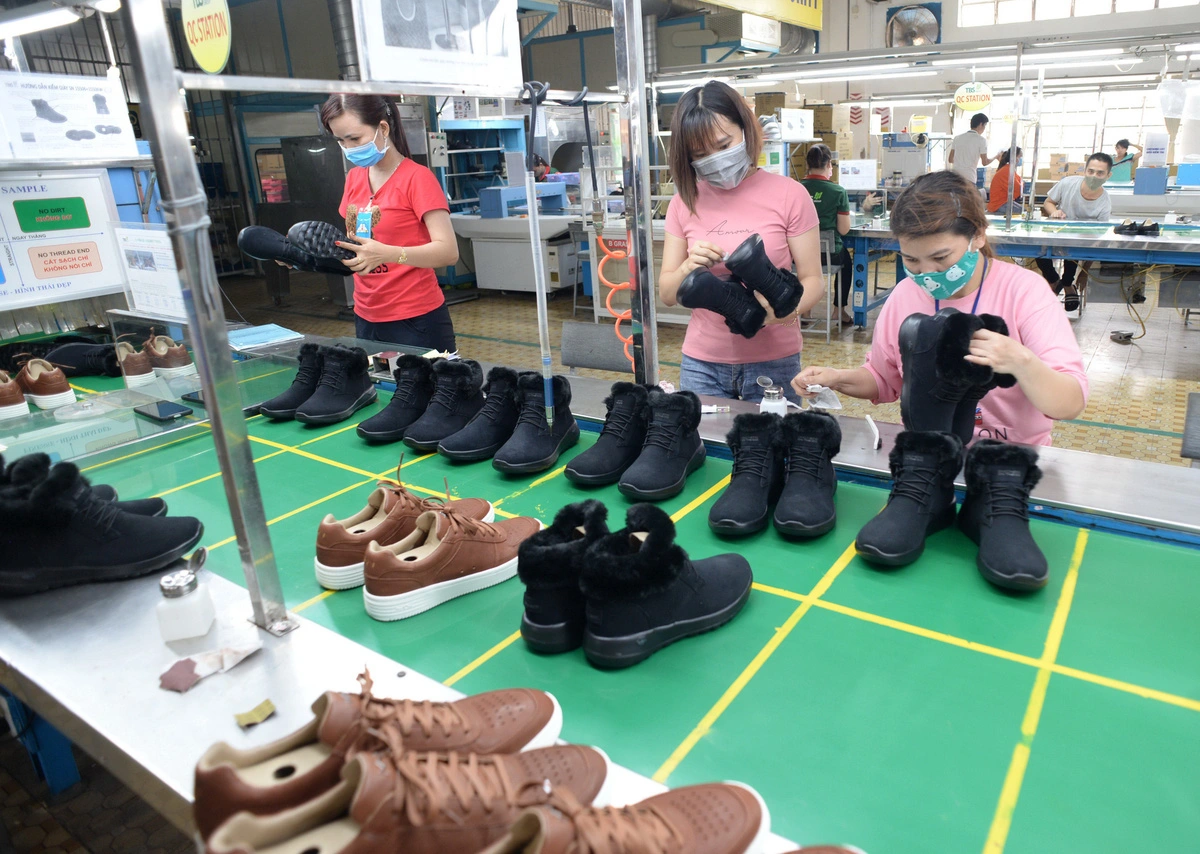Global trade tensions will also open up opportunities for Vietnam to capitalize on supply chain shifts and attract higher-quality investment flows, Minister of Industry and Trade Nguyen Hong Dien said during an interview with Tuoi Tre (Youth) newspaper.
The minister noted that in the context of global trade facing many risks, the Ministry of Industry and Trade will continue to prioritize investment in developing key export sectors in 2025, particularly industrial processing and manufacturing with high technology content such as electronics and machinery.
He added that developed countries are increasingly applying stricter standards and regulations on supply chains, raw materials, labor, and the environment for imported products.
In addition, political tensions in some regions and global trade tensions have caused container shipping fees to increase sharply.
Vietnam is also facing the challenge of export price competition due to rising logistics costs and the increasing demands of export markets.
However, in the face of the risk of expanding trade conflicts with the U.S. raising tariffs, Vietnam may have opportunities to boost production and exports to replace some suppliers in the U.S. market.
However, the country should take caution as the U.S. may impose tariffs on Vietnam’s exports given its high trade surplus with the U.S., along with origin fraud, while Vietnam's key export markets are recovering slowly.
Nevertheless, the export value of US$405.53 billion in 2024, up 14.3 percent year on year, is expected to provide a strong momentum for 2025, Minister Dien claimed.
Vietnamese enterprises have actively exploited the recovery of markets and free trade agreements, diversified markets and products, and expanded into new markets.
The minister added that key export sectors will be those with high competitiveness, such as apparel and footwear. These sectors will focus on innovating technology, transitioning to green production, and meeting international sustainability standards.
For key agricultural and seafood products with production and export advantages, Vietnam will focus on deep processing, branding, improving the ability to meet quality, food safety, and sustainability regulations and standards.
The wood sector will also focus on processing, diversifying products, improving quality, and building brands. This is a sector where Vietnam has significant advantages in raw material resources, processing capacity, and high added value.
Vietnam's wood products can meet the demand of major export markets, such as the U.S., the EU, and Japan.
The Ministry of Industry and Trade will also pay importance to supporting and promoting the development of green export industries, as countries increasingly value sustainability and environmental responsibility.
The ministry has proposed the government issue the import-export strategy in 2021-30, integrating sustainable export goals, towards a green economy, a circular economy, and emission reduction.
The ministry will apply solutions to increase the localization rate and the added value by attracting investment into the semiconductor production and export sector, meeting environmental requirements.
Along with negotiating and signing free trade agreements (FTAs), the Ministry of Industry and Trade will continue to support businesses in maximizing benefits from FTAs by organizing training programs and seminars, and providing consultation on traceability regulations to take advantage of tariff preferences, helping them understand the standards and requirements of markets under FTAs, thereby enhancing sustainable exports.
The ministry will also cooperate with relevant agencies to assist businesses in building sustainable supply chains, ensuring raw material sources meet international safety, environmental, and sustainability standards.
Programs connecting businesses with domestic and international reputable suppliers will help optimize production costs and enhance the competitiveness of Vietnamese goods, in addition to programs to support enterprises, especially small and medium ones, in digital transformation, said Dien.
The application of new technologies, production and management automation through digital platforms will not only help save costs but also enhance labor productivity, meeting increasingly high international market demands in terms of quality and delivery time.
 |
| Minister of Industry and Trade Nguyen Hong Dien. |
Cao Huu Hieu, general director of Vietnam Textile and Garment Group, cited forecasts from many global organizations to say that although 2025 will still face many difficulties, the textile and garment sector will have a better outlook.
However, Vietnam still needs to wait and see the next moves of U.S. President Donald Trump regarding tax policies to assess the impact of such policies on Vietnam's exports.
The country should be very careful in dealing with the relocation and expansion of Chinese investors’ factories in Vietnam to avoid tariffs, Hieu suggested.
However, internal changes play a large role, especially innovation in production management. The export value of $44 billion in 2024 mainly came from foreign-invested enterprises, while Vietnamese enterprises hold a small proportion.
If Vietnamese enterprises do not invest in raw material origins, the FTAs Vietnam has signed will mostly benefit foreign-invested enterprises.
According to Do Thi Thuy Huong, executive board member of the Vietnam Electronics Business Association, the electronics industry had a positive year with growth returning. Its export value reached nearly $127 billion, maintaining its leading position in the manufacturing industry. The added value of domestic enterprises is also increasing.
As a case in point, up to 250 Vietnamese companies are suppliers to Samsung, including 150 first-tier suppliers, showing that the position of Vietnamese enterprises has significantly improved since 2016 when no Vietnamese companies were suppliers to this group.
Many other enterprises are first-tier suppliers to Cannon and Foxconn, creating supply chains with many domestic enterprises.
Orders are also picking up, with some enterprises operating in three shifts and having enough orders for the entire year, proving that the electronics industry, and manufacturing as a whole has returned to its growth momentum, though not as expected.
Amid a complex and unpredictable geopolitical environment, Vietnam is a bright spot in attracting technology supply chains, Huong noted.
The government's commitments to support investors, attract high-quality FDI flows with the presence of large investors such as Qualcomm investing in chip packaging, or Nvidia committing to human resource training support, are helping to build a solid foundation for the sector’s growth.
Like us on Facebook or follow us on Twitter to get the latest news about Vietnam!

















































